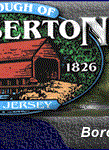The center of the Borough of Pemberton is located on a ridge of land
between the North Branch of the Rancocas to the south and Budd's Run
to the north. Like many other Burlington County towns, Pemberton owes
the initial impetus for its development to water powered industry.
The first to exploit Pemberton's water resources for industrial use
was David Budd, who had a mill on Budd's Run as early as 1740. In
1752, Budd joined with three other entrepreneurs to form the New Mills
Company.
The company not only built saw and grist mills on the Rancocas, but
also planned a company town. Lots were laid out and allocated to the
four owners. Although the distribution and size of these lots did
not ultimately determine the configuration of later building lots,
it did establish a nucleus for the town along the river bank and the
present Hanover Street. By 1785, the New Mills Company's industrial
enterprise had expanded to include a tanyard, two forges and a fulling
mill.
By this time what would, in 1826, become the Borough of Pemberton
was clearly a town. There was a store, a school, and three hotels,
which may have served as boarding houses for unmarried workers. There
were also two churches. Unlike the majority of towns in Burlington
County, where the founders were members of the Society of Friends,
Pemberton's religious roots were in the Baptist and Methodist denominations.
Baptist meetings were held as early as 1752, and the New Mills Baptist
Church was formally organized in 1764. The present church building
on Hanover Street was erected in 1861. The Methodist congregation,
founded in 1774, is the oldest in Burlington County and the third
oldest in New Jersey. The present church was built in 1895.
By 1785, there were about 70 dwellings in the town; by 1834, the number
had increased to about 100. Industry continued to flourish. Skilled
craftsmen plied their trades in the 1820s, such as the clockmaker
Joseph Budd, and Thomas Gaskill and Samuel Roberts, who made Windsor
chairs. By 1840, there were a cotton manufacturer, hat factory, manufacturer
of plough castings, turning mill, as well as three shoemakers.
This marked a watershed for Pemberton's industry. Recovery from the
depression that followed the Panic of 1837 was slow, and when it did
come, steam mills in larger cities gradually made water powered industry
obsolete. As a result, Pemberton's economy shifted during the second
half of the 19th century from industry to processing of agricultural
products and services for the surrounding area. Situated between fertile
farmland to the west and the pine barrens to the east, and with a
good transportation system, Pemberton became a distribution point
for such products as cranberries and blueberries.
Its main street boasted numerous shops and professional offices. It
was only after World War II that the business district began to decline
because of competition from office parks and shopping malls.
Today, Pemberton reflects many aspects of its long history. However,
most of the industrial complex that dominated its founding and first
100 years has vanished, although it remains as a site with rich archaeological
potential. Only one mill and a couple of cranberry packing houses
suggest Pemberton's once thriving industries.
Pemberton's earliest buildings are concentrated on Hanover and Jarvis
Streets. They include workers' housing, as well as more imposing homes
and business buildings. Built with minimal setbacks on deep, narrow
lots, they give this small town a remarkably urban air. At 9-11 Mary
Street is a small duplex, probably built as workers' housing by the
New Mills Company in the 18th century. Other workers' housing here
and along Jarvis Street is largely of later date. A number of fine
Federal townhouses exist along Hanover Street. Good examples are the
"Brick Mansion" on the west side opposite Elizabeth Street
and the house at 110 Hanover Street. The Pemberton Inn, at the southeast
corner of Hanover and Elizabeth, was built in 1839 to replace the
frame Lower Tavern. On the opposite corner is a funeral home, which
incorporates the Upper Tavern of 1782, although now dominated by a
fine Victorian iron porch. Other early buildings of interest include
a former store near the Methodist Church, the early shop windows of
which were recorded by the Historic American Buildings Survey, and
the tiny brick jail at the north end of Hough Street. Elizabeth Street
is characterized by larger dwellings built in the second half of the
19th century, widely spaced, and on ample lots.






![]()






![]()